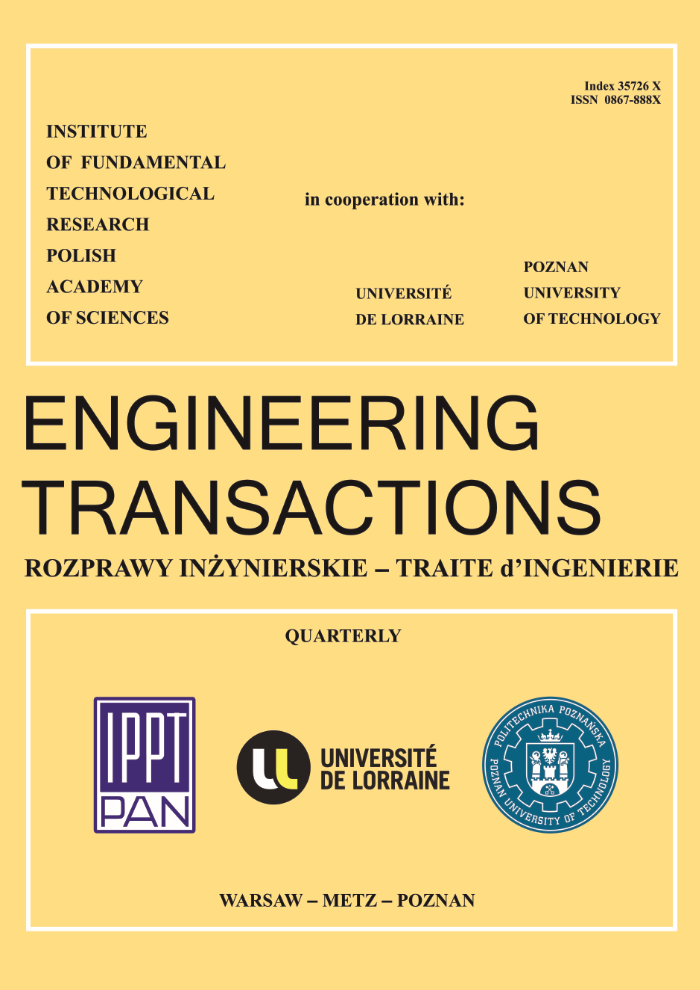Abstract
In this paper, we present the concept of Partial Factorization [1] And discuss its possible applications to the Finite Element method. We consider: (1) reduction of the element tangent matrix, which is particularly important for mixed/enhanced elements and (2) reduction of the sub-domain matrices of the Domain Decomposition (DD) equation solvers run either sequentially on a single machine or in parallel on a cluster of computers. We demonstrate that Partial Factorization can be beneficial for these applications.Keywords:
multi-scale models of multi-layer shells, mixed/enhanced finite elements, parallel computing, Domain Decomposition, solversReferences
1. Petra C.G. et al., An augmented incomplete factorization approach for computing the Schur complement in stochastic optimization, SIAM J. Sci. Comput., 36(2): C139–C162, 2014.
2. Jarzębski P., Wiśniewski K., Taylor R.L., On paralelization of the loop over elements in FEAP, Computational Mechanics, 56(1): 77–86, 2015.
3. Jarzębski P., Wiśniewski K., Performance of the parallel FEAP in calculations of effective material properties using RVE, [in:] Advances in Mechanics, Kleiber M. et al. [Eds.], Taylor & Francis, London, pp. 241–244, 2016.
4. Jarzębski P., Wiśniewski K., Application of partial factorization for domain decomposition solver, In preparation, 2016.
5. MacNeal R.H., Harder R.L., A proposed standard set of problems to test finite element accuracy, Finite Element in Analysis and Design, 1: 3–20, 1985.
6. Press W.H. et al., Numerical Recipes in Fortran 77, Cambridge Univeristy Press, 1999.
7. Anderson E. et al., LAPACK Users’ Guide, SIAM, Philadelphia, 1999.
8. HSL 2013, A collection of Fortran codes for large scale scientific computation, http://www.hsl.rl.ac.uk/.
9. Wiśniewski K., Finite Rotation Shells. Basic Equations and Finite Elements for Reissner Kinematics, Springer, 2010.
10. Wiśniewski K., Turska E., Four-node mixed Hu-Washizu shell element with drilling rotation, Int. J. Num. Meth. Engng., 90(4): 506–536, 2012.
11. Gupta A., WSMP: Watson Sparse Matrix Package, IBM Research Report,Watson, 2015.
2. Jarzębski P., Wiśniewski K., Taylor R.L., On paralelization of the loop over elements in FEAP, Computational Mechanics, 56(1): 77–86, 2015.
3. Jarzębski P., Wiśniewski K., Performance of the parallel FEAP in calculations of effective material properties using RVE, [in:] Advances in Mechanics, Kleiber M. et al. [Eds.], Taylor & Francis, London, pp. 241–244, 2016.
4. Jarzębski P., Wiśniewski K., Application of partial factorization for domain decomposition solver, In preparation, 2016.
5. MacNeal R.H., Harder R.L., A proposed standard set of problems to test finite element accuracy, Finite Element in Analysis and Design, 1: 3–20, 1985.
6. Press W.H. et al., Numerical Recipes in Fortran 77, Cambridge Univeristy Press, 1999.
7. Anderson E. et al., LAPACK Users’ Guide, SIAM, Philadelphia, 1999.
8. HSL 2013, A collection of Fortran codes for large scale scientific computation, http://www.hsl.rl.ac.uk/.
9. Wiśniewski K., Finite Rotation Shells. Basic Equations and Finite Elements for Reissner Kinematics, Springer, 2010.
10. Wiśniewski K., Turska E., Four-node mixed Hu-Washizu shell element with drilling rotation, Int. J. Num. Meth. Engng., 90(4): 506–536, 2012.
11. Gupta A., WSMP: Watson Sparse Matrix Package, IBM Research Report,Watson, 2015.






